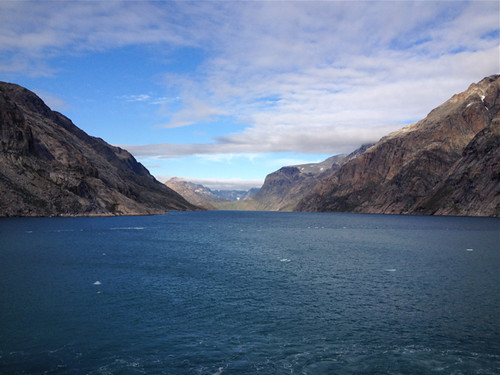
The miracle was the weather – clear, cold, and even some sun. We were told this happens rarely, even during the few summer months in which the Sound is navigable. The wonders just kept coming, as the large ship maneuvered through the Sound with cliffs rising steeply on either side. There were waterfalls around every corner,
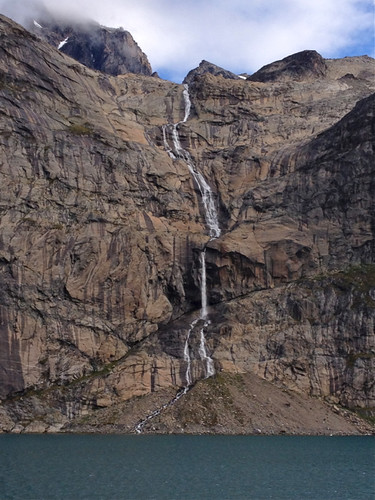
several glaciers that tumbled down to the water’s edge

and glimmering, bright icebergs.
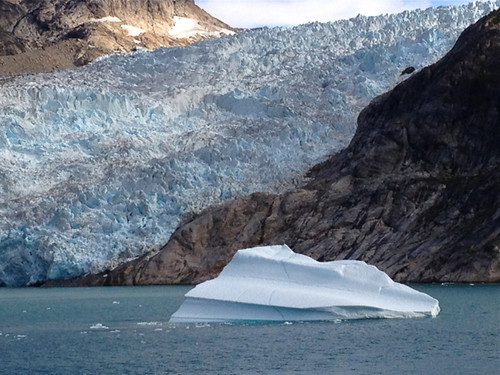
Greenland has a small population, Fewer than 60,000 live in small towns and villages around the coastline and on islands as the interior isn't habitable. While cruising through the Sound our enormous cruise ship anchored off the tiny settlement of Aappilattoq (population around 130) so that the ship's tender could deliver some supplies of fresh food and pizza to its residents. For much of the year the town is reachable only by helicopter. You can just see the colourful houses of Aappilattoq at the bottom of the picture below:

On each of the two days following our voyage through the Sound we anchored at towns on the southern tip of Greenland. In Nanortalik our cruise passengers more than doubled the local population of around 1500. There was time to stroll and linger on the seats scattered along the local streets and admire the landscape dotted with colourful small houses, and to wonder about people's lives in such a small and isolated community.
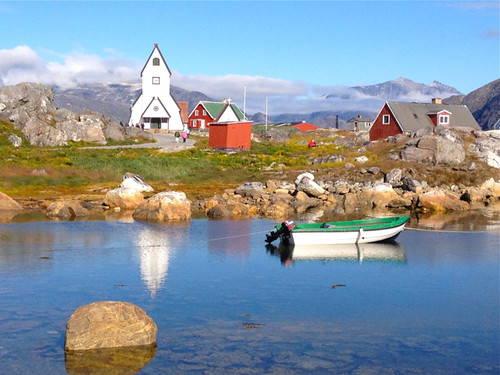
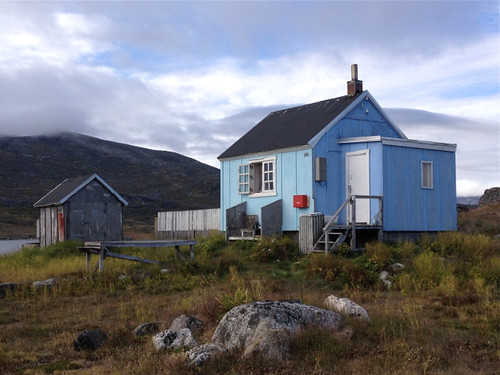
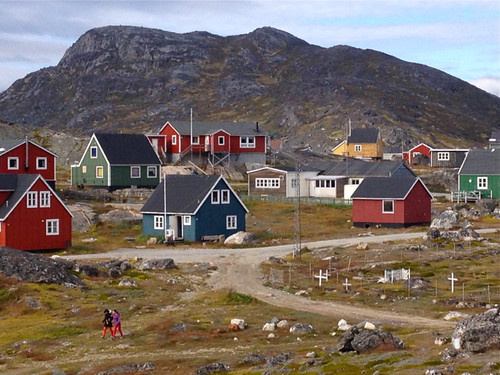
For a small fee (we scrambled to find our leftover Danish kroner) we were admitted to the community hall where the Nanortalik locals had organised coffee and cake as well as a performance by the local choir. The small choir ranged in age from members in their thirties to those in their eighties and the songs and their harmonies were disconcertingly like those of the Tongan church near me in Sydney. I suspect this similarity has more to do with the Nanortalik choir being from the local church than it does with any traditional relationship between Greenland and Tongan music! I particularly liked the two organising women in the choir who had gone to the effort of dressing in local costumes:
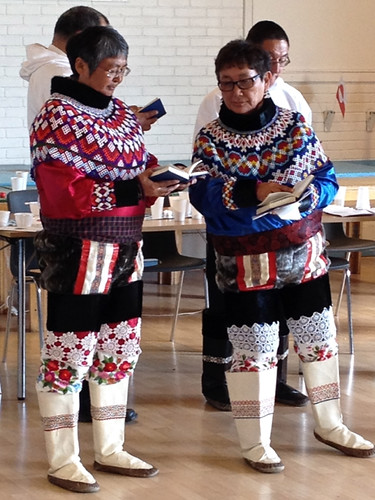
I imagine someone, somewhere, must have written a thesis, or at least an essay, on the very eclectic elements of this national costume. Some bits seem modern; others quite traditional. Maybe these combinations are just what the Greenlanders like to wear. I didn't notice what the turtleneck collars were made from (I was too overwhelmed by all the other components) but they sit above an elaborate beadwork yoke-like cape that's worn on top of a brightly coloured satin shirt with beadwork cuffs. Below the top is a patterned fabric cummerbund and then seal fur shorts with contrasting leather, fur and leather applique stripes at the front. The shorts are worn over trousers that seem to have several components including bright floral inserts and crocheted panels. The trousers are tucked into sealskin boots that also have intricate leather applique patterns. I found these costumes of many elements fascinating.
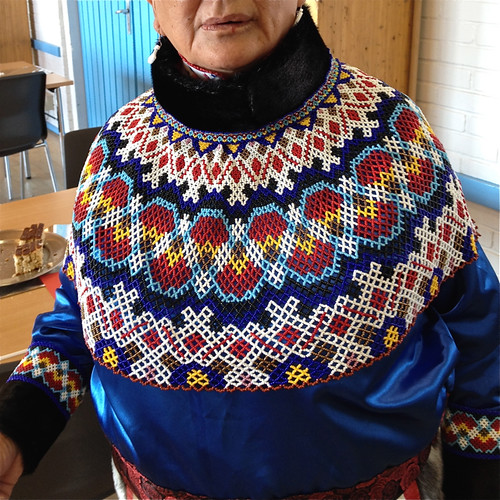
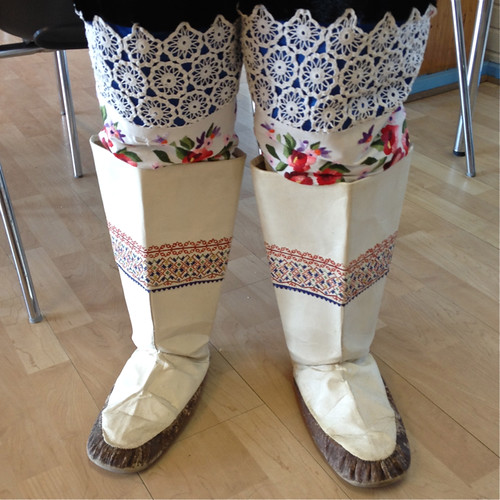

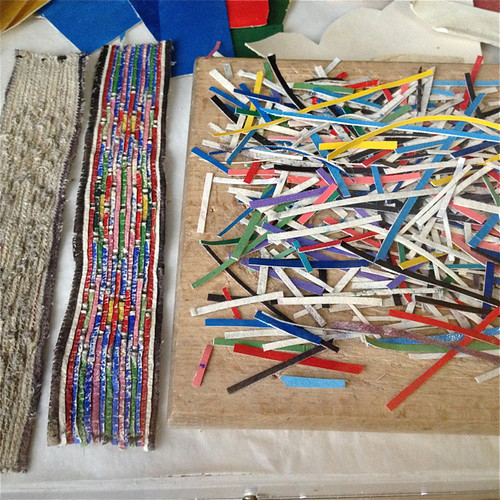
In comparison with Nanortalik, Qaqortoq, which was our final stop in Greenland, seemed bustling. Its population is around 3,000 and there's a harbour with fishing boats and a fish processing plant (and an iceberg)
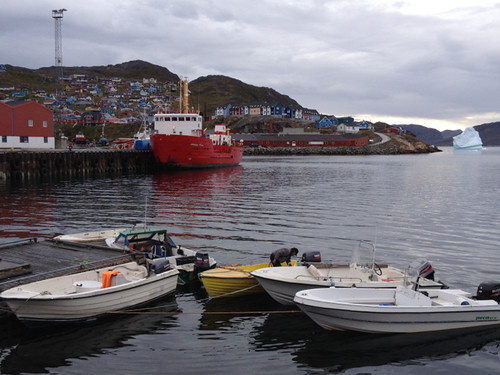
and a supermarket and a modern high school. There are even blocks of apartments where the distinctive compact architectural style and colourful siding of small houses has been carried over to the larger buildings:

Qaqortoq was still charming: it's small enough to walk from place to place and admire some of the older buildings, such as the early twentieth century church, that have been preserved:
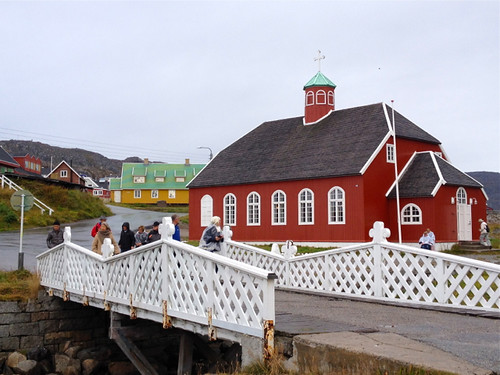
But the greatest pleasure in our visit to Qaqortoq was to see the icebergs that lingered so close to the town:
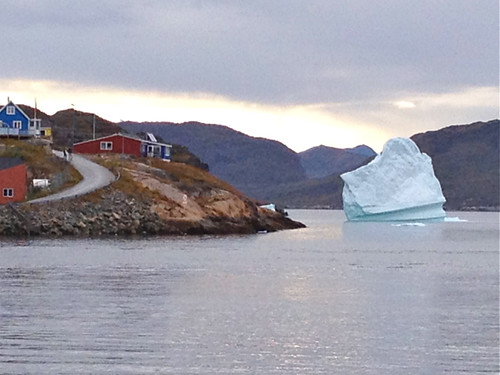
There were no yarn stores in the towns we visited in Greenland, so one would imagine there were no yarn temptations. However, there was a large tourist store at the harbour that was selling moskus garn - otherwise known as quiviut or yarn from musk oxen. This was another of those yarn transactions where if you think too much about the yarn air miles you hesitate to buy; the yarn was harvested from musk oxen in Greenland, processed in Denmark, then flown back to Greenland for the tourists to purchase. I did hesitate, but I did buy a skein.

I was particularly grateful for this glimpse of a country I imagine I will never have the opportunity to visit again. Days of miracles and wonders, indeed.
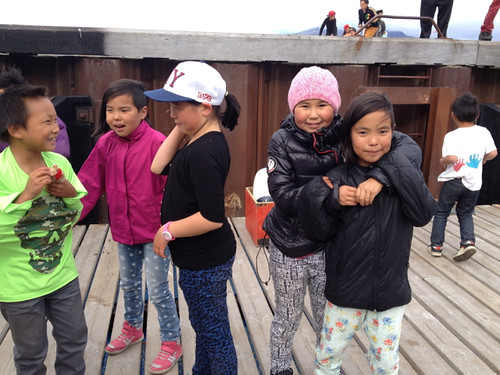
5 comments:
I must admit I haven't thought much about Greenland either but it looks amazing. But I can't quite wrap my head around living in such a remote pace with a friendly neighbourhood iceberg!
Today is Thanksgiving Day here in Canada. One of the things on my list for which I give thanks are your
wonderful travelogues. They have taken me to many places I expect I'll never see for myself. So thankyou again.
i am just gobsmacked by these glorious photos and the way the splashes of colour cut through all that grey and rock and ice. so beautiful!
Post a Comment